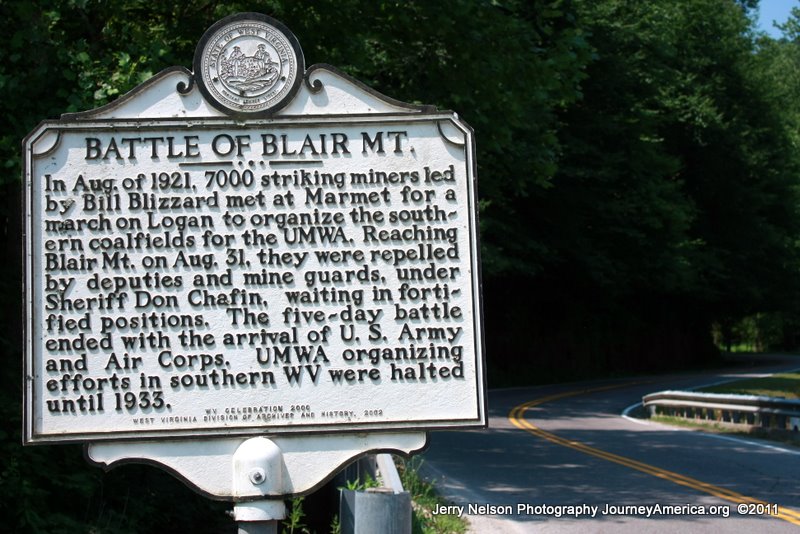
Tom Johnson reached into the corner between the pie safe and icebox. The Springfield rifle that he had brought home with him from the war was still standing there safe. He kissed his wife, Sally, goodbye, telling her not to worry. Peeking in on his daughter, Elizabeth, before stepping outside, he silently pulled the door shut behind him and walked into history.
Waiting on him outside were his friends, Buddy and Alan. They had left their homes higher in the mountain to help out. Slowly in the darkness as the last light from the full moon faded they made their way down the goat path and into the hollow where they were joined by other miners.
Like a mountain spring that forms a trickle that joins with other trickles to form a creek that joins with others to form a river, they came. They came slowly but deliberately. From every hollow and depression in this forgotten section of West Virginia they came. Like a raging torrent of river the miners gained momentum as they gathered and walked along -- the miners were on a mission.
Brutal and unfair working conditions in the West Virginia coalfields had been stirring the passion of 10,000 union miners. The spark that fired the tinderbox was the mine owner sanctioned murder of Matewan Police Chief Sid Hatfield. Hatfield had been a friend of miners since the coal companies started trying to evict striking workers from their homes.
On August 2nd, 1921, ten thousand miners assembled at Charleston in preparation for a march over rugged mountain terrain to rescue illegally imprisoned miners in Mingo County.
As the miners waited and the rebellion grew, tension rose. They didn't know that entrenched along the ridges of Blair Mountain was a private army led by Logan County Sheriff, Don Chafin. Chafin had the backing of the coal operators. The insurrectionists only had their anger to empower them.
When the two armies collided atop Blair Mountain both sides were armed with machine guns, Springfield rifles and dynamite. After four days of heaving fighting -- during which a million rounds of ammunition had been fired -- the U.S. Army arrived and stopped the bloodshed.
When in 1933, FDR finally gave labor unions the legal right to organize, the leaders of the March on Blair Mountain leaped into action. With lightning speed and efficiency the leaders organized the West Virginia southern coalfields. These same miners who had fought bravely went on to become the central founders of the United Auto Workers United Steel Workers.
It's no exaggeration to say that the Battle for Blair Mountain can be seen as the base of the emergence of the American idle class of the 1960s and was the Gettysburg of the labor movement. The mountain though has lain for years -- unmarked and forgotten -- and now is threatened with obliteration by strip mining.
To help preserve Blair Mountain and the important labor heritage, a group of volunteers has assembled to start a community center and museum. The building is located in historic Blair, WV and formerly held a church.
It will take much work and resources for the building to be used as a community center and museum. Serious infrastructure improvement needs exist for now. A leaky roof needs fixing and drinkable water and heating are in short supply. Long term donations of showcases, frames and display cases are need for the museum portion. It's estimated that the improvements and renovations will cost more than $10,000.00. A site has been set up to collect donations and a wide range of premiums are available to anyone interested in helping.
Meanwhile, the ridgeline of Blair Mountain sits quiet and lonely. A park has been proposed to commemorate the historic value of the site and the surrounding terrain already has access roads and ATV trails already in place.
Because of the threat of encroaching strip mining, the park remains a dream. Since the mid 90s, citizens have tried repeatedly to place Blair Mountain on the National Register of Historic Places. The influence of coal companies in WV state politics has stopped all efforts. Strip mining permits currently in place will allow Blair Mountain to be mined without legal recourse.
A campaign to save Blair Mountain has been growing in recent years, culminating in the summer of 2011 with a modern March on Blair Mountain. One thousand union miners and mountain activists gathered to urge state and federal governments to save this one mountain and its history.
The trickle of volunteers is slowly joining with other trickles. The determination with which descendants of the original miners -- along with their friends and supporters -- is only matched by those that joined with Tom Johnson that August morning in 1921.
Jerry Nelson is a nationally recognized photojournalist and adventure photographer. His work has appeared in many national, regional and local publications including CNN, USAToday, Upsurge, Earthwalkers and Associated Content and he is a regular contributor to Huffington Post as well as OpEdNews. Nelson travels the country seeking out the people, places and things that make America unique and great. Nelson currently is in Washington D.C. pointing his camera at OccupyDC and freelancing for The Washington Times the second largest paper in the nation's capital.
CLICK HERE to see more of Nelson's work or to hire him for a shoot.